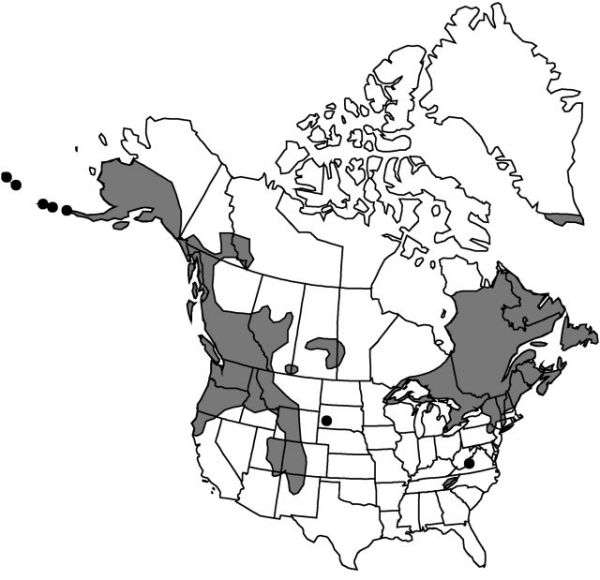Streptopus amplexifolius
in J. Lamarck and A. P. de Candolle, Fl. Franç. ed. 3, 3: 174. 1805.
Plants from thick rhizomes. Stems freely branched, stout, 5–12 dm, often with reddish hairs basally, nodes not fringed. Leaves 5–15 × 2.5–6 cm; blade ovate-oblong to oblong-lanceolate, base cordate-clasping, apex acuminate; peduncle: junction with pedicel abrupt, with glands indicating transition, entire structure 2–5 cm, glands short-stalked. Flowers 1–2 per axil; perianth campanulate; tepals spreading, recurved at tips, white to greenish yellow, narrowly oblong-lanceolate, 9–15 mm; stamens unequal, outer shorter, 0.8–1 mm, inner 2–3 mm; anthers lanceolate, 3–3.5 mm, apex 1-pointed; style stout, 4–5 mm; stigma fused from base to tip, unlobed; combined peduncles and pedicels recurved, 2–5 cm, short-stalked glands indicating transition; pedicel sharply geniculate, glabrous. Berries whitish green maturing to yellowish orange or red, ellipsoid, 10–12 mm. Seeds 2.5–3 mm. 2n = 16, 32.
Phenology: Flowering late spring–mid summer.
Habitat: Rich moist coniferous and deciduous woods
Elevation: 0–2800 m
Distribution

Greenland, St. Pierre and Miquelon, Alta., B.C., Man., N.B., Nfld. and Labr., N.W.T., N.S., Ont., P.E.I., Que., Sask., Yukon, Alaska, Ariz., Calif., Colo., Conn., Idaho, Maine, Mass., Mich., Minn., Mont., N.H., N.Mex., N.Y., N.C., Oreg., Pa., S.Dak., Tenn., Utah, Vt., Va., Wash., W.Va., Wis., Wyo., Eurasia.
Discussion
Several poorly defined races described by N. C. Fassett (1935) as varieties based chiefly on minute difference in leaf-margin serration are not here recognized.
Selected References
None.
